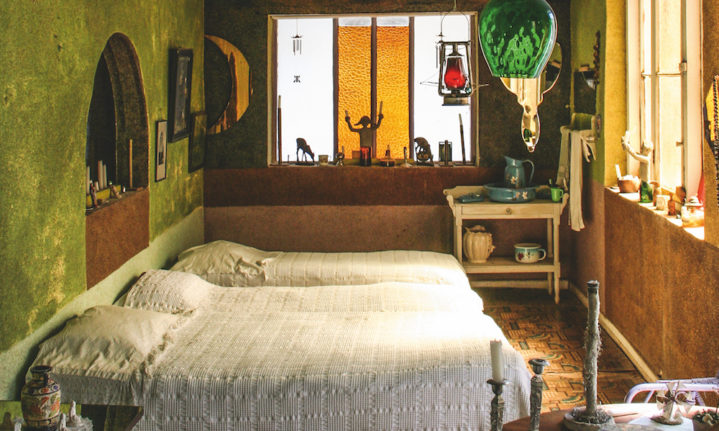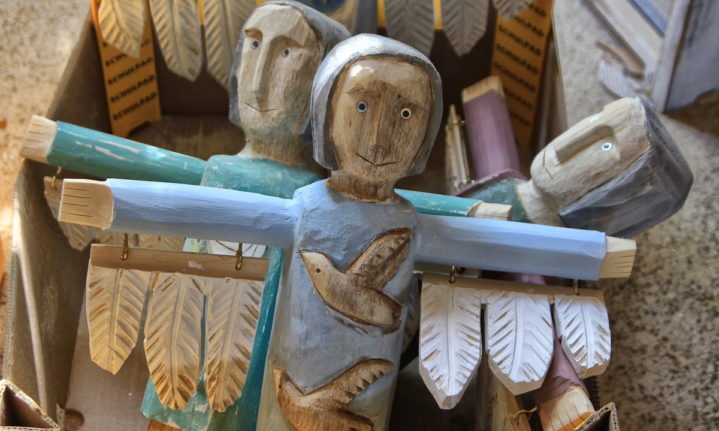By Chris Marais and Julienne du Toit
Like its famous water furrows, a strong creative spirit flows through this Karoo settlement, connecting and inspiring all who come here.

The hidden village in the mountains – Nieu-Bethesda in spring.
The little village of Nieu-Bethesda, tucked in a fold of the Sneeuberg Mountains in the Eastern Cape Karoo, is one of the most stimulating artistic touchstones of South Africa.
Musicians arrive in battered old split-window Kombis, set up a stage at a local bar, plug in and play for the hat and the love. Writers hire cottages for the winter and settle in behind log fires, laptops and good coffee to finish overdue book projects. Some never leave.
Painters, potters and sculptors also move here for the long haul, often staying on for decades beyond their initial plans. For inspiration, they simply step out of their front doors, inhale the fresh Karoo air and walk the dusty streets under the kindly gaze of the ever-present Compassberg peak – mostly in the general direction of Boetie’s Pub for a sundowner.
Some dwell in comfort and style, others in tumbledown villas, some export their work at dollar prices while others struggle on slim pickings.
In the end, it’s really all the same. Nieu-Bethesda, this place with the owls, gives them the space to tap into their inner artist and create, create, create. They make things out of nothing.
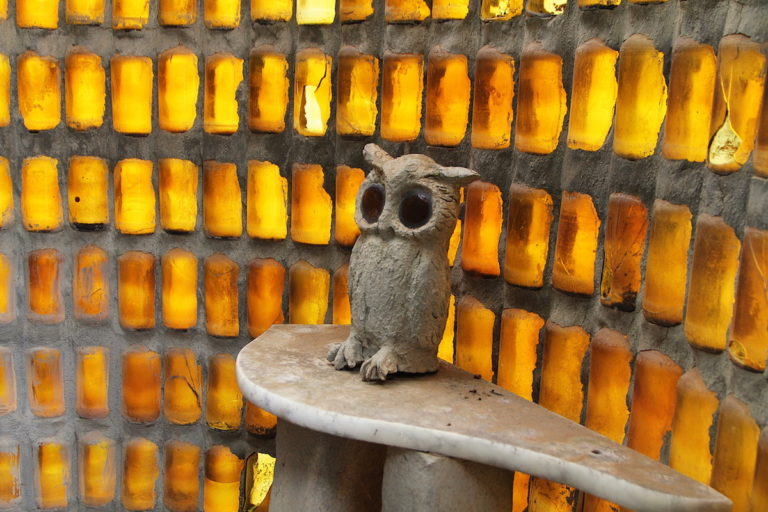
Tucked deep in an alcove of beer bottles in the Camel Yard of the Owl House is the little bird that started it all.
Part of it means allowing yourself to be bored, to get up in the middle of the night with a table saw, a pen, a sudden spark of inspiration gleaned from a dream, to fumble, to stumble, or let fate take a turn.
There is also natural art here in spades. Cold, heavy clouds. The way leaves fall. A pale chanting goshawk on a telephone pole. Goats heading home for the evening. Poplars donning warm autumn colours. The vlaktes in velvet light. Snow in winter, pear blossoms in spring. That beautiful jagged mountain.
World-class wildlife artist David Langmead, who’s done some of his best work in Nieu-Bethesda, adds: ‘You feel the ebb and the flow of the seasons in a small Karoo town like this. In winter, you become winter. When it is bleak, you become bleak. And then, in the springtime, you blossom.’
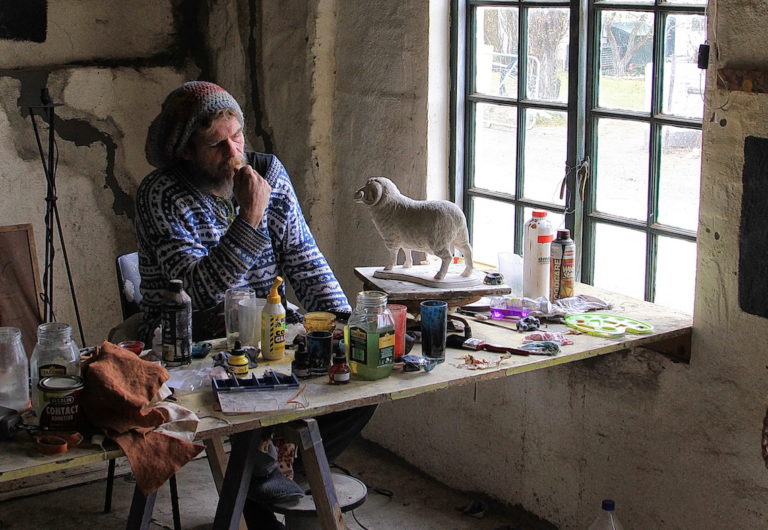
Sculptor Frans Boekkooi contemplating his Merino statuette.
How can Nieu-Bethesda bring out such wonders in people, when other dorpies fail miserably? Is it the legacy of Helen Martins and her Owl House, the words of playwright Athol Fugard that followed, or the ancient San who were the first artists in these snowy mountains?
Perhaps everything feeds off everything else.
Helen is inspired by the Bible, William Blake, the Rubáiyát of Omar Khayyám, brown beer bottles and Sunbeam Wondershine tin lids. She designs figures out of glass and cement, collaborating with local crafter Koos Malgas.
Out of this, a folk art industry emerges. You can now choose from cement mermaids, owls, tortoises or serving maids at the craft stalls outside the Owl House, even a rabbit with eyes that glow in the dark when you put a lit candle inside it.

One of the Owl House bedrooms – the ground glass on the walls catches every light- beam that enters.
Athol Fugard buys a Karoo cottage in Nieu-Bethesda, hears about the story of Helen Martins, and writes a landmark play called The Road to Mecca based on elements of it. The Fugard Arts Festival springs up for a few years because of this.
Helen gives a few of her mermaids to Johan Weitz’s grandmother and he eventually inherits them. They now live at what used to be the late Egbert Gerryts’s place, The Ibis Lounge. This is one of the world’s first honesty restaurants – he doesn’t charge you for the food; instead, he asks you to contribute what you think it was worth.
‘People invariably overpay,’ he once told us. Helen’s art also feeds the imagination of Lindy Faiers, who draws in pen slightly hallucinogenic versions of her figures, camels and ecstatic women, sitting outside her tiny house with Cara the miniature wolf dog, a plank (called The Laptop) across her knees.
Daleen Kruger comes for the Fugard Fest of 2011 to present a play on Helen Martins and Koos Malgas, and ends up staying in the town. She now makes angels out of agave stems and poplar wood.
Ian and Katrin Allemann, attracted by the rebel nature of Helen Martins, call their Backpackers ‘Outsiders’ and, later on, bring more and more musicians to town. They come just for the fun of being there and interacting with the locals. We’re talking major names, such as Roger Lucey, Koos Kombuis, Steve Newman and the amazing Vusi Mahlasela.
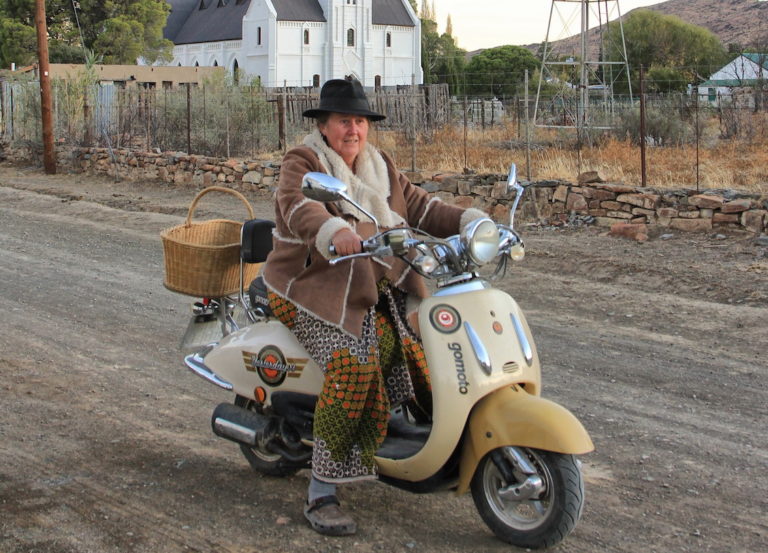
Daleen Kruger, angel artist, on an evening scoot through Nieu-Bethesda.
Then, the late sculptor Marcella de Boom is somewhat influenced by Helen’s Outsider Art statues and comes up with The Dance, 10 life-size cavorting figures in the veld on a farm near Loxton in the Northern Cape. Side-car motorbike maven Ryno Greeff hears about it, chats to local farmer Peet van Heerden and hey, presto! We have The Stone Folk of Ongeluksloot, a collection of wire-and-rock mountain figures that have become another reason to stick around and spend more time in the Sneeuberg.
Intrigued by Fugard’s play, Johannesburg artist, swimming coach and world traveller Gregg Price buys a plot in the village and builds his dream Karoo escape, complete with a gallery and a labyrinth dedicated to his late son William.
‘Like the other artists here, I am attracted to the landscape,’ he says. ‘It’s incredibly beautiful, but it’s harsh as well, and that dangerous edginess shapes the art you make.’
So everything becomes intertwined. Egbert’s daughter still lives here, with Reinet le Roux, who is creative in her own way – a driving force behind several festivals, including the Pump Palooza Pumpkin Fest and Fugard Festival. Reinet still runs an honesty shop out of her home on the corner of Martin and Grave streets.
Boetie Bester, everyone’s favourite publican and a former truck driver of international repute, launches the Nieu-Bethesda Garlic Festival.
Roasted garlic ice cream is the most popular and near-perennial item on the Tasting Menu at Stirlings Restaurant, which used to be The Ibis Lounge. This is where Barbara Weitz conjures culinary magic from flavours harvested in the veld with Neville Swiers, who is the guy selling agave stems, succulents and planters outside the Owl House.

Carved angels from poplar and agave.
Victoria Nance at the end of the road runs Dustcovers, rated one of the best country bookshops in South Africa. Her most popular books? Those on the Karoo and the Owl House. And she is always running out of copies of The Road to Mecca.
Ceramicists Charmaine and Martin Haines sell their work in the big cities of South Africa and abroad. Speak to Charmaine about her time as a resident artist in Nieu-Bethesda and she will tell you:
‘This place opens the mind, gives you time for retrospection and reflection, for authentic experiences. Being in such a small village makes you aware of all the harsh aspects of life as well. But that awareness helps you make something out of nothing (there’s that phrase again) and you realise that the Karoo is a sacred space, with its ancient seas and its fossils. You want to defend it against threats like fracking and uranium mining.
‘Living in a small town forces you to look at what is around you. You think of making chimes from bones, bird-feeders from agave roots. Sometimes inspiration comes from a stark place, out of a need to earn a buck. Like a fellow we knew who literally started selling bottles of Karoo air. Can you believe it? Flogging fresh air!’

Martin and Charmaine Haines have added greatly to the creative spirit of Nieu-Bethesda.
On a morning ramble, we come upon Justin Duckitt outside Die Waenhuis venue, making a mini-biome out of a formerly unused section of leivoor (water furrow) outside the spot he shares with his partner, Jacques Muller. Being the local Mr Fixit extraordinaire, he’s probably the most creative person in town. Certainly the handiest.
‘Come and look at my old 1974 Frigidaire oven,’ he calls out to us, and we follow him inside, catching the matchless aroma of early morning baking.
Justin has done his sourdough loaves perfectly, and proceeds to get granular on exactly how he baked them. Helpful hint: at the height of summer here, you really need someone like Justin on speed-dial. He supplies the whole village with ice. We cross the Gats River to visit sculptor Frans Boekkooi, whose work first caught our fancy more than a decade ago when he made the incredible Visman Steier (literally Fisherman Staggers, but actually a character out of an Etienne van Heerden novel) figure and a masterful bust of Mr Karoo himself, Fugard, complete with beanie and beard.
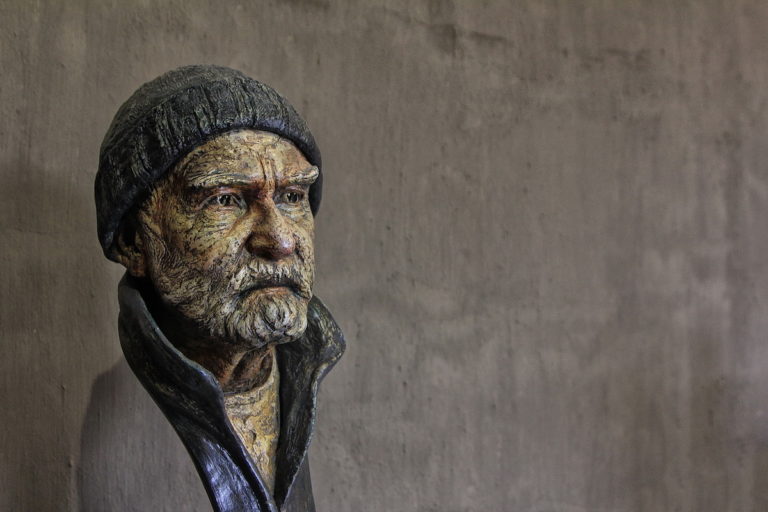
An exquisite rendering of Athol Fugard by Frans Boekkooi, one of the most well- known sculptors in Nieu-Bethesda.
Frans now has his own gallery, where his figures (we see a girl sunbathing, a donkey cart carrying away computer trash, an alert meerkat and yes, there’s Mr Fugard) are on display. We catch this fine artist in his workshop, contemplating the finishing touches to a champion Merino he’s just made.
Even overnight travellers are spellbound by the mojo of Nieu-Bethesda.
Kim Goodwin is the Master Caster of the KZN Midlands, running his Lion’s River foundry and occasionally crossing the vast Karoo to work with the AfrikaBurn crowd down in the Tankwa desert. He always tends to sleep over in Nieu-Bethesda. ‘I come here for some soul space,’ he says. ‘Who would have thought that a sculptor and a playwright could have put a little spot like this on the world map? It’s a village transformed by art.’
ALSO READ









